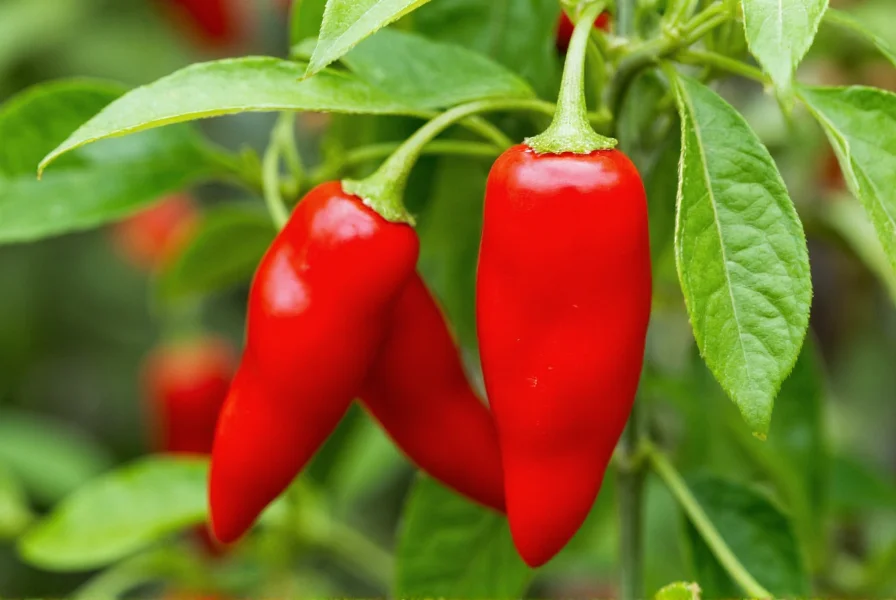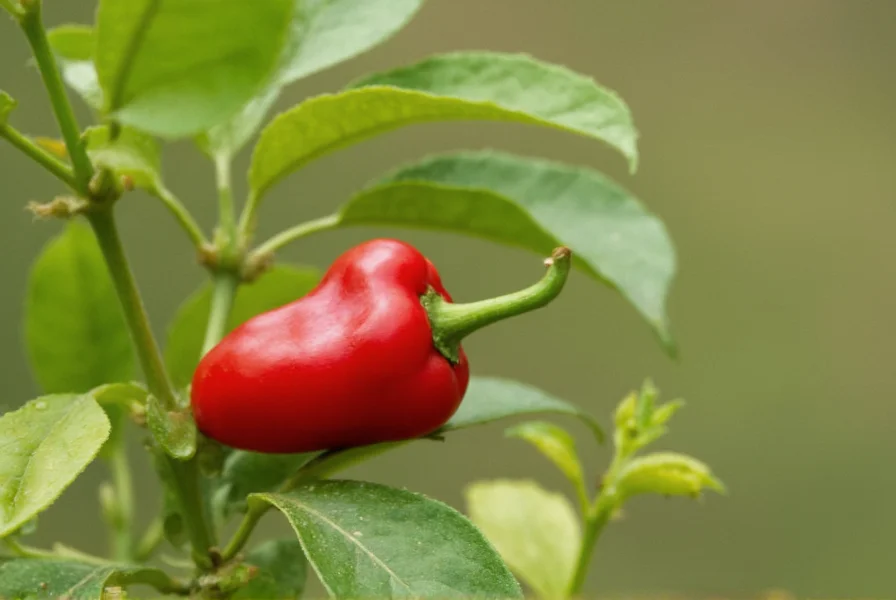Bird pepper has earned its name from birds' ability to consume these fiery fruits without experiencing the burning sensation that affects mammals. Unlike humans, birds lack the receptors that respond to capsaicin, the compound responsible for chili heat. This biological quirk actually helps with seed dispersal, as birds eat the peppers and spread the seeds through their droppings.
Characteristics and Identification
Bird peppers are easily distinguishable by their small size and distinctive shape. They typically measure between 1-2 inches in length with a conical or teardrop shape. The peppers grow upright on the plant rather than hanging down, which is characteristic of many Capsicum frutescens varieties. When immature, they appear green, then transition through yellow and orange stages before reaching their final bright red color at full maturity.
The heat level of bird pepper ranges from 50,000 to 100,000 Scoville Heat Units, placing it in the same heat category as the habanero but generally considered slightly milder. However, heat can vary significantly based on growing conditions, with stressors like drought often increasing capsaicin production.
| Pepper Variety | Scoville Heat Units | Size (inches) | Flavor Profile |
|---|---|---|---|
| Bird Pepper | 50,000-100,000 | 1-2 | Fruity, citrusy, floral |
| Habanero | 100,000-350,000 | 1-2.5 | Tropical fruit, apricot |
| Scotch Bonnet | 100,000-350,000 | 1-2 | Sweet, fruity, smoky |
| Jalapeño | 2,500-8,000 | 2-3.5 | Grassy, bright |
Origin and Historical Significance
Bird pepper originated in Central and South America but spread globally through trade routes. Portuguese traders introduced it to Africa and Asia during the 15th and 16th centuries, where it became integral to many regional cuisines. In Jamaica, bird pepper became a key ingredient in traditional jerk seasoning and is sometimes called "Jamaican hot pepper" or "Caribbean red pepper."
The scientific name Capsicum frutescens refers to its semi-woody growth habit, distinguishing it from other chili species. This perennial plant can grow up to 3-5 feet tall in ideal conditions and continues producing fruit for multiple seasons in tropical climates.

Culinary Applications and Flavor Profile
Bird pepper's culinary value extends beyond its heat. It offers a complex flavor profile with distinct citrus and floral notes that enhance dishes without overwhelming them. In Caribbean cooking, these peppers feature prominently in sauces, marinades, and traditional dishes like Jamaican jerk chicken. West African cuisines use bird peppers in stews and soups, where they provide both heat and depth of flavor.
When using bird pepper in cooking, chefs often remove the seeds and inner membranes to control heat levels, as these parts contain the highest concentration of capsaicin. The peppers work well in both fresh and dried forms, with drying intensifying their fruity characteristics while maintaining significant heat.
Growing Bird Pepper Successfully
Cultivating bird pepper requires specific conditions for optimal growth. These plants thrive in warm climates with temperatures between 70-90°F (21-32°C) and need well-draining soil with a pH of 6.0-7.0. They require full sun exposure for at least 6-8 hours daily and consistent moisture without waterlogging.
Gardeners in cooler climates can grow bird peppers in containers that can be moved indoors during colder months. The plants typically produce flowers 6-8 weeks after planting, with peppers maturing in 70-80 days from flowering. For maximum heat development, allow peppers to fully ripen to red on the plant before harvesting.

Nutritional Benefits and Health Considerations
Bird peppers contain significant amounts of vitamin C, vitamin A, and capsaicin, which research suggests may offer several health benefits. Capsaicin has been studied for its potential to boost metabolism, reduce inflammation, and provide pain relief when applied topically. The vitamin C content in fresh bird peppers exceeds that of citrus fruits by weight, making them an excellent source of this essential nutrient.
However, the extreme heat requires careful handling. Always wear gloves when preparing bird peppers and avoid touching your face. If you experience burning sensations, dairy products like milk or yogurt can help neutralize the capsaicin, while water typically spreads the compound and worsens the sensation.
Common Misconceptions About Bird Pepper
Many people confuse bird pepper with similar-looking varieties like habaneros or Scotch bonnets. While they share visual similarities and heat levels, bird peppers typically have a more upright growth habit on the plant and slightly different flavor profiles. Another misconception is that all small red peppers are bird peppers—many commercial "bird eye" peppers sold in markets are actually small Thai chilies (Capsicum annuum).
Understanding the differences between bird pepper vs habanero is crucial for cooks seeking authentic flavors. Habaneros tend to be slightly larger with a more rounded shape and often exhibit more pronounced tropical fruit notes, while bird peppers deliver a cleaner, sharper heat with citrus undertones.
Frequently Asked Questions
How hot is bird pepper compared to other common chili varieties?
Bird pepper measures between 50,000-100,000 Scoville Heat Units, making it approximately 10-20 times hotter than jalapeños (2,500-8,000 SHU) but generally milder than habaneros (100,000-350,000 SHU). It shares heat intensity with cayenne peppers but offers a more complex, fruity flavor profile compared to cayenne's straightforward heat.
Can I substitute bird pepper if I can't find it?
Yes, the closest substitutes for bird pepper are small habaneros or Thai bird chilies. For similar heat with slightly different flavor, use half a habanero per bird pepper called for in a recipe. If you need milder heat, serrano peppers work as a substitute but provide less intense heat and different flavor notes. For authentic Caribbean dishes, avoid using bell peppers or milder varieties as they won't provide the necessary heat profile.
What are the ideal growing conditions for bird pepper plants?
Bird pepper plants require warm temperatures (70-90°F), full sun exposure (6-8 hours daily), and well-draining soil with pH 6.0-7.0. They need consistent moisture but cannot tolerate waterlogged conditions. In cooler climates, grow them in containers that can be moved indoors during colder months. These plants typically reach maturity in 70-80 days from flowering and will continue producing for multiple seasons in tropical environments.
How should I handle bird peppers safely in the kitchen?
Always wear gloves when handling bird peppers and avoid touching your face, especially eyes. Work in a well-ventilated area as capsaicin can become airborne when cutting peppers. If you experience burning, use dairy products like milk or yogurt to neutralize the sensation—water will spread the capsaicin and worsen the burn. After preparation, thoroughly wash all surfaces and utensils with soapy water to remove residual capsaicin.
What distinguishes bird pepper from other small hot peppers?
Bird pepper (Capsicum frutescens) differs from similar small hot peppers in several ways. Unlike Thai bird chilies (Capsicum annuum), bird peppers grow upright on the plant rather than hanging down. Compared to habaneros, they're typically smaller with a slightly different flavor profile—more citrus-forward versus habanero's tropical fruit notes. Bird peppers also have a thinner wall than Scotch bonnets, affecting their preservation qualities and culinary applications.











 浙公网安备
33010002000092号
浙公网安备
33010002000092号 浙B2-20120091-4
浙B2-20120091-4